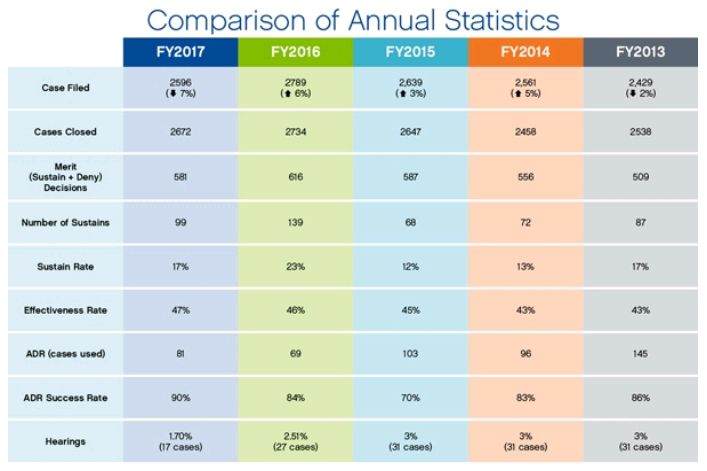In Short
The Situation: The Government Accountability Office publishes an annual report detailing bid protest activity for the prior fiscal year.
The Result: The fiscal year 2017 report shows that the sustain rate for bid protests has decreased, but the effectiveness rate—the percentage of protests where the filer is granted some form of relief—remains high, at 47 percent.
Looking Ahead: Over the last two years, federal agencies followed every recommendation that GAO made. This indicates that the significance of GAO as a bid protest forum will continue.
Each year, GAO publishes its Bid Protest Annual Report to Congress for the previous fiscal year. This report contains several important statistics about GAO bid protests and identifies any instances in which a federal agency failed to fully implement a GAO bid protest recommendation.
Background
Last year, we discussed the sharp increase in the sustain rate (23 percent for FY 2016) from the previous year (12 percent for FY 2015). We also noted that, perhaps even more significant than the spike in the sustain rate, was the fact that the effectiveness rate had risen to 46 percent, representing the highest effectiveness rate GAO had ever reported to Congress. GAO's effectiveness rate represents the percentage of protests in which a protester obtained some form of relief—either through a decision sustaining the protest or through an agency voluntarily taking corrective action. This year, GAO's report shows that, while the sustain rate has decreased, the effectiveness rate remains high.
Comparison of Annual Statistics


The Current Situation
Although the sustain rate significantly decreased this year (from 23 percent to a more modest 17 percent), closing approximately half of the gap between the 2015 and 2016 rates, it still represents an increase over the rates seen in 2014 and 2015. We believe the more significant statistic is the effectiveness rate. This year's 47 percent rate tops last year's record-breaking high. Since the effectiveness rate represents sustained protests plus voluntary agency corrective action, the increase in this rate coupled with the decrease in the sustain rate indicates that GAO saw a sharp increase in the number of agencies taking voluntary corrective action in response to protests. This might be due to agencies' awareness of GAO's high sustain rate in 2016, and their unwillingness to "roll the dice" and wait for a formal decision from GAO, given the increased likelihood that the decision could be a sustain. It could also be due to agencies doing a better job of analyzing protests early in the protest process to determine which protests are meritorious. Agencies that take corrective action prior to the agency report due date may avoid having to pay protest costs associated with meritorious protests.
Finally, it is worth noting that the number of cases filed at GAO decreased by 7 percent in FY 2017. This is undoubtedly due—at least in part—to the jurisdictional rollercoaster for GAO task and delivery order protests in FY 2017. As we previously reported, GAO's jurisdiction to hear protests regarding task orders issued against a multiple-award IDIQ contract vehicle awarded by a civilian agency expired on September 30, 2016 (the end of FY 2016). Therefore, GAO began FY 2017 with no jurisdiction to hear civilian task order protests. The jurisdiction to hear protests against task orders issued by civilian valued at $10 million or more agencies was eventually restored on December 14, 2016, through the "GAO Civilian Task and Delivery Order Protest Authority Act of 2016." However, the 2017 National Defense Authorization Act (NDAA), signed just a few days later, revoked a portion of GAO's task order jurisdiction for Department of Defense ("DOD") procurements by raising the jurisdictional threshold for such protests to $25 million. Since then, contractors seeking to challenge DOD task order awards valued under $25 million have been unable to seek redress at GAO. GAO's 2016 and 2017 reports demonstrate the impact of these changes in task order jurisdiction—in FY 2016, task order protests represented 13.7 percent of the cases closed at GAO, while in FY 2017, the percentage of task order protests dropped to 9.6 percent of closed cases.
Finally, GAO's annual report also informs Congress each year of each instance in which a federal agency did not fully implement one of GAO's recommendations in connection with a bid protest decided in the prior fiscal year. This year, as last year, GAO reported that there were no such instances—agencies followed every recommendation that GAO made. The fact that agencies followed every single GAO recommendation last year highlights the significance of GAO as a bid protest forum and the value of GAO's bid protest decisions.
Two Key Takeaways
- GAO's record high effectiveness rate shows that protesters have nearly a 50 percent chance of obtaining some form of relief in response to a GAO protest.
- The modifications to GAO's task and delivery order jurisdiction has resulted in a decrease in overall protests to GAO, depriving some companies of the opportunity to seek redress for flaws in procurements.
The content of this article is intended to provide a general guide to the subject matter. Specialist advice should be sought about your specific circumstances.


